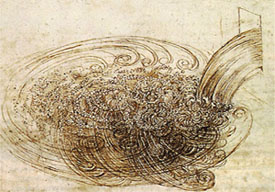Big
whorls have little whorls which feed on their velocity,
and little whorls have lesser whorls and so on to viscosity.
--Lewis
Richardson
Team
Formation
Investigators
from many different disciplines have teamed up via the Center
for Integrative Multiscale Modeling and Simulation (CIMMS) to
model and analyze complex phenomena across multiple time and length
scales. The challenge to CIMMS investigators is to help lay the
foundation and further specific application areas of multiscale
systems. Representative goals are to accurately model, simulate,
and control multiscale systems in the presence of uncertainty
or errors that might occur across scales. This work will be enabled
by the interaction between research groups in multiscale modeling
and those in multiscale geometric algorithms. Advances in these
two areas are significant but isolated, and CIMMS members intend
to systematically bridge the gaps between these two communities.
CIMMS will become an intellectual hub for Caltech graduate students,
postdocs, and faculty in research areas such as Control & Dynamical
Systems, Mechanical Engineering, Computer Science, Electrical
Engineering, Applied & Compu-tational Mathematics, and Bioengineering.
The Center will also function as a crossroads for industry researchers
working on similar multiscale modeling and simulation problems.
Researchers will collaborate through workshops, individual interactions,
seminars, student internships, and industrial exchanges. A center
with national visibility, CIMMS will allow Caltech to lead an
intensive, focused effort to create an application-oriented and
systematic multiscale approach to a wide range of scientific and
engineering challenges.
To
represent this multi-task and multi-goal center, investigators
selected a drawing by Leonardo da Vinci (below). This image is
an exquisite delineation of the turbulent flow of fluid as it
involves vortices within vortices over an ever-decreasing scale.
Da Vinci´s study of the complexity of a "relatively" simple
phenomena, water flowing and mixing, illuminates the essence of
the levels of multiscale modeling and simulation.

CENTER
MISSION
Despite their ubiquity, multiscale systems are rather poorly understood
from a fundamental perspective. CIMMS´s mission includes
two over-arching themes. The first is to develop a basic "core"
infrastructure for the study of multiscale systems (see diagram
this page). A prototypical challenge is to reliably compute larger,
resolvable coarse scales while accurately modeling the net effect
of smaller, or subgrid, scales in both materials and fluids. There
have been some successes, but there is a need for enhanced cooperation
across disciplines to make significant progress. The second theme
is to demonstrate the effectiveness of tools developed in the
"core" on a variety of interesting application areas.
EXPLORATION
& EXAMPLES
Study
areas such as atmosphere and ocean dynamics, material microstructures,
and biomolecular dynamics remain enormous challenges to computational
modeling. More CPU cycles are good but will go only so far.
A
profound understanding of mathematical modeling coupled with efficient,
accurate algorithms in an integrative environment will allow researchers
to better understand how water flows in the open ocean and how,
for example, it mixes with pollutants. What happens before, during,
and after an earthquake fault ruptures? How can we minimize risk
of engine failure in any flying condition for the next generation
of jet engines? These, and others, are the kinds of problems CIMMS
researchers will study, model, simulate, and control.
Strain
on an earthquake fault can take many years to build, but release
occurs in seconds. Seismic waves can travel across continents,
but local effects (in the Los Angeles basin, for example) may
be of utmost concern. The difference in both temporal and spatial
scales for these phenomena is enormous.
A
jet engine involves the complex interaction of fluids, combustion,
fan blades, and other engine parts that operate on many different
scales. One needs to operate and control such complex processes,
often close to stability margins, for greater efficiency. A representative
CIMMS task is the creation of tools and techniques to enable virtual
jet engines to reliably simulate flight events, material properties,
and dynamical phenomena.
Perhaps
the greatest multiscale system is our own solar system, contained
within our Milky Way galaxy. One can observe the planets moving
on a grand scale while simultaneously witnessing the delicate
intricacies of Saturn´s rings and the turbulent red spot
on Jupiter, with its own "whorls within whorls."
Without
the crucial element that CIMMS hopes to provide, monoscale approaches--even
supersized--will remain insufficient to fully model, analyze,
and control complex phenomena.







